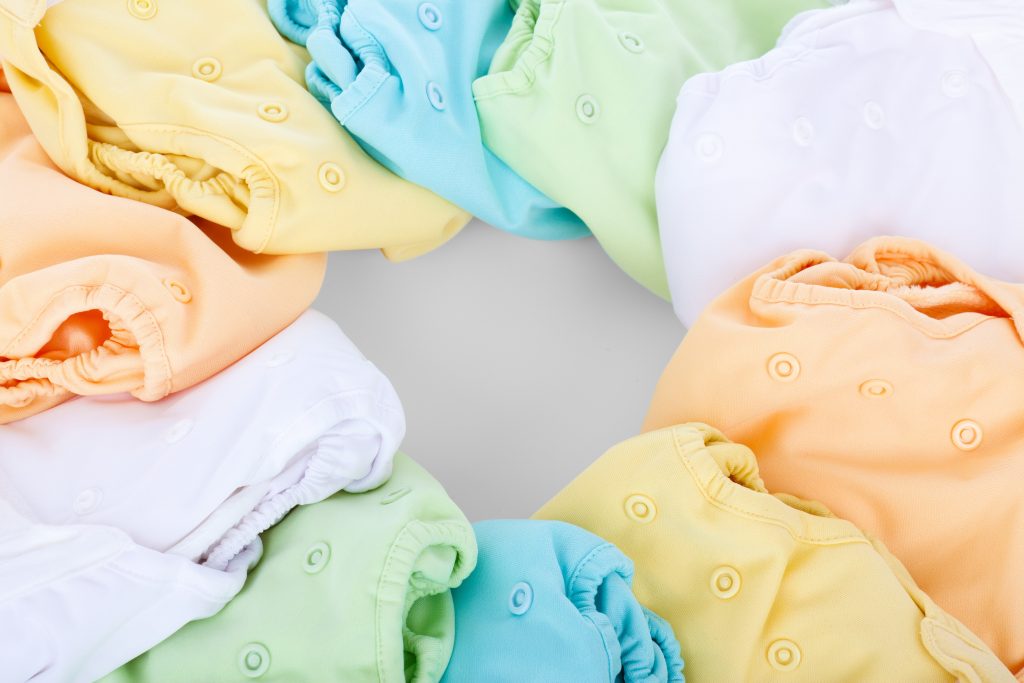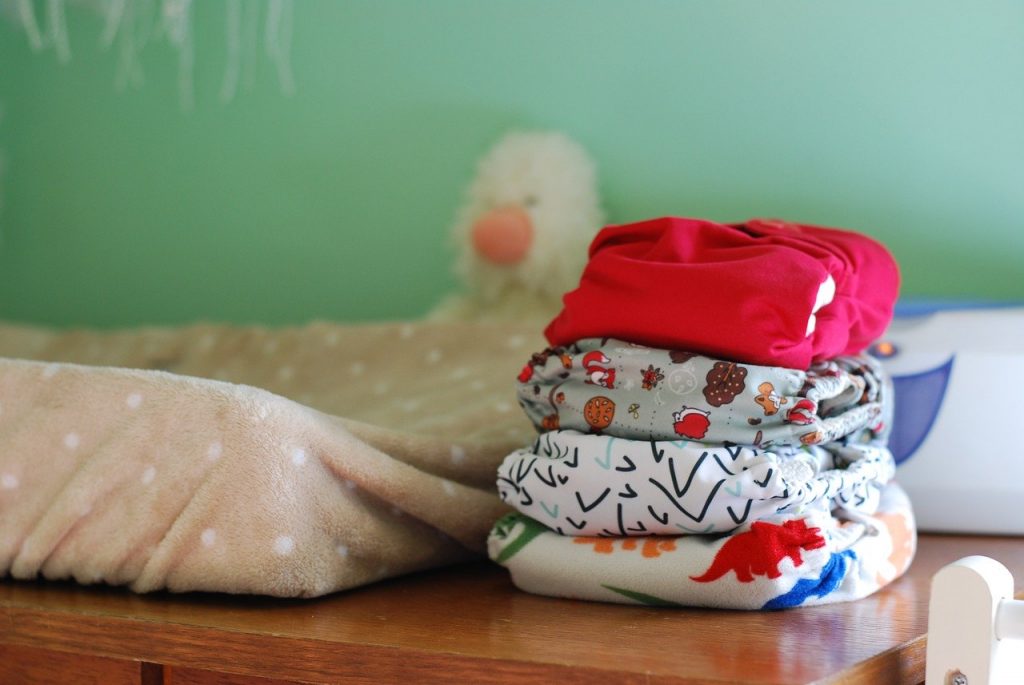Cloth diapers are a wonderful way to help the environment, keep your baby cleaner and safer, and eliminate the fixed costs of disposables. There are three main types of cloth diapers, and each variation comes with different pros and cons for usage.
Three Types of Cloth Diapers
A pre-fold diaper includes three rectangular panels made from lightweight gauze-like fabric with extra absorbency layers in the center. Pocket diapers have a liquid-proof outside and a pocket on the inside to put absorbent inserts. All in one diapers are typically the easiest variation of cloth diapers to use and come with an absorbent liner and a waterproof outer barrier that does not separate in the wash like pocket diapers.

Best Pre-Folded Cloth Diapers:
- Gerber Baby Organic Cotton Flatfold Birdseye Diaper One Size — $12.99 for a 10pk at Target
- Humble Bebe Prefold Cloth Diapers Unbleached Premium Cotton — $36 for a 12pk at Amazon
- Smart Fit Organic Cotton Prefolds — made from 55% Bamboo and 45% Organic Cotton $28.95 for a 6pk at NickisDiapers.com
Best Pocket Cloth Diapers:
- Charlie Banana Reusable One-Size Diaper — $124.99 for a 6pk at Target
- EcoPosh Organic Bamboo Velour (OBV) — $32.99 NickisDiapers.com
- Alva Baby One Size Adjustable Baby Cloth Diapers (includes 12 inserts) — $39.99 for a 6pk at Amazon
Best All-in-One Diapers:
- Thirsties Snap Natural One Size All In One — $26.99 for a 1pk at Target
- Thirsties Natural One Size All In One Diapers have 11 layers of natural fibers! – $25.95 at NickisDiapers.com
- bumGenius Freetime All-in-One One-Size Cloth Diaper — $246.60 for a 12pk at bumGenius.com
Upsides to using cloth diapers
- Cloth diapers are better for baby’s skin.
Babies who wear cloth diapers are less likely to get a rash, but you need to change them more often to avoid that. If you neglect regularly changing the cloth diapers, you’ll still end up with a diaper rash, the same as disposable diapers. However, with cloth diapers, you must change them more often than disposable diapers because they are often less absorbent and do not fit your baby the same way disposable diapers do.
If you do end up with a diaper rash, you cannot use regular diaper rash cream because they affect the absorbency of the cloth diapers. Instead of typical diaper rash creams and ointments like A&D Ointment, you can try plain coconut oil or organic diaper rash products specifically designed for cloth diapers. Earth Mama makes an organic diaper balm that soothes and heals without damaging your cloth diapers.
- Cloth diapers come in a variety of styles to meet your needs and skills.
Cloth diapers come in three primary styles: pre-folded, pocket, and all-in-one. Which one you choose for your baby mainly depends on how much time you want to invest in cleaning and maintaining the diapers. Some cloth diapers need to air dry while others are designed to throw in the washer and dryer without the hassle of taking out an insert or separating any pieces.
If you’re not invested in the cleaning process, but you still want to use cloth diapers, you might do better with all-in-one diapers that need minimal maintenance. If you prefer only cleaning the insert and not having to clean the waterproof barrier every time, pocket diapers are the best option. If you want to go about the process less expensively and more traditionally, pre-folded diapers are an excellent choice.
- Cloth diapers save you money in the long-term.
Cloth diapers are a significant initial investment, but they save you considerable money over the years that you use and reuse them. Consider cloth diapers as a long-term investment in both your wallet and the environment.
According to Children’s Hospital Los Angeles, the total cost for cloth diapers is $250 compared to a monthly price of $100 for the eco-friendly disposables and $55 for basic disposable diapers. Most families can start with 12 diapers and add more as they need them. When you use disposable diapers, you always need to buy new ones to replace all of the soiled ones.
- Cloth diapers have few or no chemicals.
Disposable diapers, especially the non-eco-friendly diapers, often contain chemicals like chlorine or perfumes like polyacrylate. They might also have volatile organic compounds (VOCs) like ethylbenzene, toluene, xylene, and dipentene. The Environmental Protection Agency (EPA) writes that VOCs are known to cause eye, nose, and throat irritation along with potential damage to the liver, kidneys, and central nervous system.
Many disposable diapers use dyes, fragrances, or even plastics in the construction of the diapers, all of which are potentially harmful to your baby. Quality and organic cloth diapers typically do not include chemicals or VOCs.
- Cloth diapers prevent landfill waste.
Up to 95% of U.S. families use disposable diapers. That means millions of diapers are disposed of in landfills every day. Disposable diapers are labeled municipal waste by the EPA, meaning that they are considered safe to be disposed of in solid waste landfills. However, adding to the mountains of landfill waste that already exist is not something to take lightly.
Cloth diapers from companies like Nicki’s allow you to reuse the same diapers time and time again, possibly through the entire time your child wears diapers. When you reuse diapers, you cut down on how many disposable diapers end up in the landfill, which reduces your carbon footprint and prevents any chemicals in the diapers to leach into the ground.

Downsides to using cloth diapers
- Cloth diapers are not always environmentally friendly.
It’s one thing to campaign for keeping disposable diapers out of the landfills, but its another thing entirely when you consider the amount of energy cloth diapers require to stay clean. The answer to which type of diaper is better for the environment isn’t as clear cut as you might like.
Disposable diapers can leach bacteria and chemicals into the ground when they sit in landfills. Cloth diapers require frequent or daily washing and drying to keep up with your baby’s needs. The amount of electricity and water you consume to maintain the cloth diapers might be equal to or even outweigh the possible dangers of disposable diapers in landfills.
The EPA does not take a stance on whether disposables are worse or better for the environment because there is no clear answer. Municipal landfills are required to comply with federal regulations enacted to protect the environment from contaminants. Household washers and dryers have few restrictions on the amount of use and water consumption.
- Cloth diapers are bulky and take up a lot of room.
Cloth diapers have thicker absorbent layers than do disposable diapers. This makes them bulkier to carry in a diaper bag and to put on your child. You might find that you have to put your baby in clothing one size too big so that it fits around the cloth diaper, which can get expensive and time consuming to figure out. If this sounds like too much of a hassle, cloth diapers might not be the way to go.
- Cloth diapers are an expensive investment in the short term.
How many do you need to start? The answer isn’t that easy to figure out. Every family and baby is different. Many parents decide to buy 12 or more cloth diapers to start with. However, because cloth diapers are challenging to use with newborns, you might decide to use disposable diapers for newborns and then move into cloth diapers when your baby is big enough to fit into them.
Whatever number you choose to start with, cloth diapers are not cheap. Many types cost between $13 to $20 for one diaper. This is especially true for organic ones. If you decide to go the cloth diaper route, you might get spooked by the upfront cost, but if you wait long enough and keep using them, you usually save money in the long-term.
Are cloth diapers worth the hassle?
Cloth diapers are a lot to get used to all at once. You might find that you’re overwhelmed by your choices and the maintenance requirements, especially if you try to jump wholeheartedly into their usage from the beginning.
Instead of buying cloth diapers in bulk with the expectation that you will never use a disposable diaper, try buying only a few and waiting to see what works better for your lifestyle. Not every parent is cut out to handle the needs of cloth diapers. They require a lot of cleaning and attention, and if you decide to air dry instead of using an electric dryer, that process can take days.
However, if you can get used to cloth diapers, there are a lot of benefits for your baby, and you’re keeping disposable diapers out of the landfill. Weigh the pros and cons of each and do a trial run before committing to an expensive purchase that might not work out.
